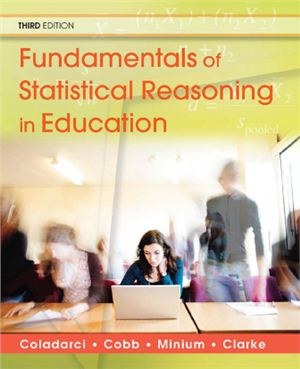Wiley – 2011, 462 pages
ISBN 9780470574799
Fundamentals of Statistical Reasoning in Education 3e, like the first two editions, is written largely with students of education in mind. Accordingly, we draw primarily on examples and issues found in school settings, such as those having to do with instruction, leaing, motivation, and assessment. Our emphasis on educational applications notwithstanding, we are confident that readers will find Fundamentals 3e of general relevance to other disciplines in the behavioral sciences as well.
Our overall objective is to provide clear and comfortable exposition, engaging examples, and a balanced presentation of technical considerations, all with a focus on conceptual development. Required mathematics call only for basic arithmetic and an elementary understanding of simple equations. For those who feel in need of a brushup, we provide a math review in Appendix A. Statistical procedures are illustrated in step-by-step fashion, and end-of-chapter problems give students ample opportunity for practice and self-assessment. (Answers to roughly half of these problems are found in Appendix B.) Almost all chapters include an illustrative case study, a suggested computer exercise for students using SPSS, and a Reading the Research section showing how a particular concept or procedure appears in the research literature. The result is a text that should engage all students, whether they approach their first course in statistics with confidence or apprehension.
ISBN 9780470574799
Fundamentals of Statistical Reasoning in Education 3e, like the first two editions, is written largely with students of education in mind. Accordingly, we draw primarily on examples and issues found in school settings, such as those having to do with instruction, leaing, motivation, and assessment. Our emphasis on educational applications notwithstanding, we are confident that readers will find Fundamentals 3e of general relevance to other disciplines in the behavioral sciences as well.
Our overall objective is to provide clear and comfortable exposition, engaging examples, and a balanced presentation of technical considerations, all with a focus on conceptual development. Required mathematics call only for basic arithmetic and an elementary understanding of simple equations. For those who feel in need of a brushup, we provide a math review in Appendix A. Statistical procedures are illustrated in step-by-step fashion, and end-of-chapter problems give students ample opportunity for practice and self-assessment. (Answers to roughly half of these problems are found in Appendix B.) Almost all chapters include an illustrative case study, a suggested computer exercise for students using SPSS, and a Reading the Research section showing how a particular concept or procedure appears in the research literature. The result is a text that should engage all students, whether they approach their first course in statistics with confidence or apprehension.

